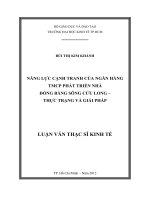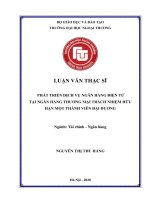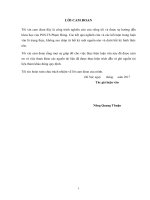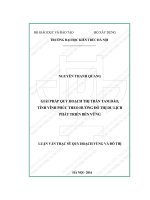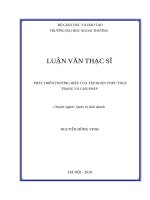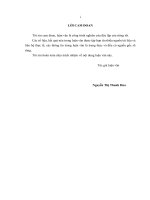Luân văn thạc sĩ chiến lược phát triển thảo dược tại công ty cổ phần traphaco
Bạn đang xem bản rút gọn của tài liệu. Xem và tải ngay bản đầy đủ của tài liệu tại đây (876.35 KB, 84 trang )
LuẬN văn: Chiến lược phát triển thảo dược tại Công ty cổ phần
TraPhaCo
THESIS TOPIC
“STRATEGIC DEVELOPMENT HERBAL
MEDICINES OF TRAPHACO JOINT STOCK
COMPANY 2015-2020”
INDEX
CHAPTER I:...........................................................................................................5
1.1. The concept and the role of the business strategy to the enterprises:........5
1.1.1. Some concepts of business strategy:...........................................6
Figure 1.2: The process of planning.................................................10
Figure 1.3: The process of planning business strategy.......11
Figure 1.5: .Macro environment.........................................................14
Board of directors and executive directors.....................................................19
Members of board of directors:......................................................................19
Table 2.1: Remarkable Achievements:............................................22
Table 2.2: Growth speed 2006-2010.........................................................24
Figure 2.1:EPS and Growth of revenue at Traphaco............24
Table 2.3: Products portfolio:............................................................26
Figure 2.2: Revenue of consuming the pharmaceuticals
and average...................................................................................................33
Figure 2.3: Traphaco's market share in Vietnam's
pharmaceutical industry.....................................................................36
Figure 2.4: Traphaco's market share in Vietnam's
pharmaceutical industry.....................................................................36
Figure 2-5 Model of value chain.......................................................41
Figure 2.6: Structure.................................................................................42
Table 2.7: PRODUCTION CAPACITY OF THE MACHINE LINE............43
Figure 2.7:Revenuse structure by products..............................48
Figure 2.8: Cost price structure and the average gross
profit of products.....................................................................................49
Table 2.9: Effective criteria 2006-2010..............................................50
Table 2.10:Operation capacity 2006-2010...........................................51
Table 2.11:Capital structure 2006-2010.............................................51
Table 2.12: Solvency 2006-2010.................................................................52
Table 2.13: Profitability 2006-2010........................................................52
Table 2.14: Analysis SWOT.........................................................................54
Table 3.1:SWOT matrix model to determine the product
development strategic applied at Traphaco.........................62
Table 3.2: Specific business plan of the herbal medicine to
2015......................................................................................................................... 64
Figure 3.1:Structure of Gross Profit according to the
product.............................................................................................................65
c/ Distribution solution..........................................................................69
- Build a professional distribution system applying the advanced
management technology in the whole three regions: Northern, Central
and Southern...........................................................................................69
List Figure and table
Figure
Figure 1.1:Three levels of strategy in the business....Error: Reference source not
found
Figure 1.2: The process of planning...............Error: Reference source not found
Figure 1.3: The process of planning business strategy.....Error: Reference source
not found
Figure 1.4: Four blocks create competitive advantage.. Error: Reference source
not found
Figure 1.5: .Macro environment......................Error: Reference source not found
Figure 1.6: BCG matrix.................................. Error: Reference source not found
Figure 1.7: SWOT Matrix................................Error: Reference source not found
Figure 1.8: Space matrix................................. Error: Reference source not found
Figure 1.9: Basic stages of strategic administration.......Error: Reference source
not found
Figure 2.1:EPS and Growth of revenue at Traphaco....Error: Reference source
not found
Figure 2.2: Revenue of consuming the pharmaceuticals and average........Error:
Reference source not found
Figure 2.3: Traphaco's market share in Vietnam's pharmaceutical industry.
.......................................................................... Error: Reference source not found
Figure 2.4: Traphaco's market share in Vietnam's pharmaceutical industry.
.......................................................................... Error: Reference source not found
Figure 2-5 Model of value chain....................Error: Reference source not found
Figure 2.6: Structure....................................... Error: Reference source not found
Figure 2.7:Revenuse structure by products. .Error: Reference source not found
Figure 2.8: Cost price structure and the average gross profit of products Error:
Reference source not found
Figure 2.9: BCG MATRIX............................. Error: Reference source not found
Figure 2.10: Space Matrix..............................Error: Reference source not found
Figure 3.1:Structure of Gross Profit according to the product. Error: Reference
source not found
Table
Table 2.1: Remarkable Achievements:..........Error: Reference source not found
Table 2.2: Growth speed 2006-2010...............Error: Reference source not found
Table 2.3: Products portfolio:........................Error: Reference source not found
Table 2.4: Brands of expanded category..........Error: Reference source not found
Table2.5: System of quality standard applied at TRAPHACO....Error: Reference
source not found
Table 2.6: The product groups brand extension......Error: Reference source not
found
Table 2.9: Effective criteria 2006-2010..........Error: Reference source not found
Table 2.10:Operation capacity 2006-2010.......Error: Reference source not found
Table 2.11:Capital structure 2006-2010..........Error: Reference source not found
Table 2.12: Solvency 2006-2010......................Error: Reference source not found
Table 2.13: Profitability 2006-2010.................Error: Reference source not found
Table 2.14: Analysic SWOT........................... Error: Reference source not found
Table 2.15: External Factors Environment (EFE) of Traphaco Company in
comparison with competitors (in the Herbal medicine)Error: Reference source
not found
Table 2.16: Internal Factors Environment (IFE) of Traphaco Company in
comparison with competitors (in the Herbal medicine)Error: Reference source
not found
Table 3.2: Specific business plan of the herbal medicine to 2015...............Error:
Reference source not found
ACKNOWLEDGEMENTS
To complete our Capstone Project Report, Group 5 – Class M0709 would like
to send our sincerely thanks to:
- The professors, and the doctors of the master training program in Master of
Business Administration (MBA), held by Griggs University collaborating with the
ETC, who taught and guided us during the training process.
- The academic staff of the Griggs University who guided us in the process of
doing the research;
- The officers and staff of the ETC belonging to the Postgraduate Department,
Hanoi National University;
We also would like to send our sincerely thanks to Traphaco Corporation, the
leader board of the Corporation, especially Ms. Vu Thi Thuan, Chairman of
Manager Board and CEO of Traphaco Corporation who enthusiastically supported
us in the process of implementing the Capstone Project Report.
Group Members:
1. Nguyen Thi Muoi
2. Le Thanh Ha
3. Tran Dinh Dong
4. Tran Huong Giang
1
OVERVIEW
The 21st century marked the changing of the world in the fields of economy,
society, politics, science and technology ... many new technologies has
continuously launched, the regulations on controlling the quality are becoming
tighter and tighter, the environment has many unexpected changes, the impact of the
spread financial crisis causing severe consequences in many countries,... Besides,
the economy of the world is shifting to the trend of global integration, so the
operations of the enterprises must be suited to the trend of the global economy, and
the regional and international integration by searching and promoting comparative
advantages to win in an increasingly fierce and intensive competition in the nation,
international and global.
In that context, each enterprise has new opportunities to exploit; at the same
time they have to face much risk should be prevented and limited. Therefore, to
adapt to business environments with high efficiency and long-term success
requiring Vietnamese enterprises in general and the pharmaceutical corporations in
particular must have a strategic thinking, which means to have a long-term vision to
ensure the survival and development of the enterprises.
Besides, the enterprises trading in the pharmaceutical sector - a particular type
of enterprise, doing business in the health and safety of the community must meet a
series of GMP - WHO requirements (standard manufacturing medicine as
recommended by the WHO). To overcome these challenges and take advantage of
opportunities well require the enterprises in the pharmaceutical industry to choose
the right orientation, to define an appropriate and timely business strategy.
Before the general reality of the pharmaceutical manufacturing enterprises in
Vietnam, and with the desire to offer a highly practical business strategy helping to
effectively take advantage of the opportunity to bring the pharmaceutical
manufacturing industry of Vietnam to grow and expand to the world. With the help
of the staff in Traphaco Corporation, after a process of doing the research, gathering
documents, studying and analyzing, the members of group 5 decided to choose and
do the research topic:
2
“STRATEGIC DEVELOPMENT HERBAL MEDICINES OF TRAPHACO JOINT STOCK
COMPANY 2015-2020”
1. Subject of the research:
There currently are two major kinds of medicine on the market; those are herbal
medicine and western medicine. However, the proportion of people using the western
medicine is much higher. The lower proportion of herbal medicine does not means its
treating effect is not as good as that of western medicine, but it mainly dues to the
medicine using habits of the people, the orientation of the doctors to patients, (because
most of doctors can enjoys the commissions from the patient's prescription from the
foreign pharmaceutical corporations). Besides, the herbal medicines of the domestic
pharmaceutical corporations are limited and lack diversity that does not meet the
requirements of the patients.
According to the survey of WHO for seven groups of common western medicine
used in Vietnam, based on the criteria of the type, the name of specific medicine,
producer and supplier showed that medical prices in Vietnam are higher from 5 to 40
times compared with the general prices in the world (according to online dantri on the
26th of June 2010).
Besides, at present, the domestic medicine is only about 652/1.563 of active
ingredients, and according to the World Health Organization (WHO), Vietnamese
pharmaceutical industry is in development levels between 2.5 to 3 (in the
classification scale from 1 to 4), that means it only produces some of certain generic
medicines and exports some pharmaceuticals, the pharmaceutical enterprises mainly
invest in manufacturing the common and simple pharmaceuticals only, with much
overlapping, do not pay attention to invest in production of specialty medicines, or
special dosages, and generally the enterprises meeting the requirements of ASEAN
GMP and GMP-WHO are low.
With orientation to create breakthrough in technology to apply the products from
nature into the production creating higher value products with good effect from which
discovers and exploits the medicinal resources to serve the protection of public
health. The Traphaco Corporation - with 39-year experience in the pharmaceutical
sector has chosen the main business direction is to trade and manufacture the herbal
medicines
3
Through understanding the overview of the pharmaceutical industry of Vietnam,
the achievements and limitations of the pharmaceutical corporations in general, and
Traphaco Corporation in particular, the subject of this research is to focus on activities
as well as strategies for developing the herbal medicine at Traphaco Corporation.
2. Scope and Objectives of the Research:
This Capstone Project Report Analysis deeply the current status of Traphaco
Corporation by positioning the enterprise with the theoretical model to identify
weaknesses and strengths, opportunities and challenges of the enterprise from which
help Traphaco Corporation not only have the strategic business plans, but also have
solutions to implement those strategies the most effectively.
For this purpose, Group 5 - Class M0709 would like to focus on building
strategies for development of the herbal medicines in the period of 2011-2015 at
Traphaco Corporation.
Through the matrix model of SWOT, our group confirms that the strategy of SO
(the combination of strengths and opportunities) is the optimal strategy for the
production of herbal medicines at Traphaco Corporation. What is the objective of the
strategy? What is the content of the strategy? What solutions are placed for the
process of building the strategy? Will these issues be addressed in this Capstone
Project Report?
3. Research Methodology:
To implement the topic: “STRATEGIC
DEVELOPMENT HERBAL MEDICINES OF
TRAPHACO JOINT STOCK COMPANY 2015-2020”,
our group agreed to use the method of
data survey, then based on theories studied to Analysis and offer comments, reviews,
recommendations to build the strategies for development of the herbal medicines in
the period of 2011-2015 at Traphaco Corporation.
General principle for making any decision, or in other words, to make a
conclusion on any issue, we must be based on actual surveyed results combined with
the academic theories.
This Capstone Project Report mainly uses method of collecting secondary data
including:
- Internal data of Traphaco Corporation;
- Sources from books, internet;
4
- Using some references, documents specialized in domestic and foreign Strategic
Management.
In addition, our group also uses the method of statistical sample, survey, and
analyzing the questionnaires.
4. Structure:
Beside the introduction and the conclusion, the Capstone Project Report includes
3 main chapters:
Chapter I: General theory of business strategy
Chapter II: The current business situation of Traphaco herbal medicine
Chapter III: Strategy development herbal medicine of Traphaco Joint Stock
Company 2011-2015.
CHAPTER I:
GENERAL THEORY OF BUSINESS STRATEGY
1.1. The concept and the role of the business strategy to the enterprises:
5
1.1.1. Some concepts of business strategy:
The term of "strategy" comes from the military field. In military, the strategy is
known as: the art to coordinate the military, political, spiritual, economic forces
mobilized to win the enemies, and the basic argument is one can crush its opponents,
even a bigger and more powerful one, if one can lead the game and put the opponents
on the favorable battle-field for deploying the capabilities (advantages). Today, the
businessmen consider the market as the battlefield, so the term of "strategy" has been
used so much in business.
Although the term of business strategy has appeared for a long time, there has no
really an accurate and complete concept. According Michael E. Porter professor of
Harvard University: "Business strategy is the art to create the competitive
advantages". Thus, business strategy is one of the means to compete among the
enterprises, it is a measure for the enterprises to achieve business goals by creating
and building the competitive advantages meaning to create or build up the strengths,
opportunities, risks and challenges ... then find out appropriate solutions to win in the
business. (Source: Curriculum of Strategic Management, MBA, Griggs University).
But according to the consulting staff of Boston Consulting Group (BCG): "the
business strategy is the allocation of available resources for the purpose of changing
the balance of available resources of the enterprise, and gain the competitive
advantage", that means the enterprises from analyzing their resources, and their
departments to allocate the resources the best from which give out the goals, and
measures to achieve goals with the highest efficiency creating the competitive
advantage. (Source: Curriculum of Strategic Management, MBA, Griggs University).
In the definition of Mintzberg's 5 Ps generalizing the aspects of Strategic
Management as follows:
+ Plan: series of the consistently planed actions.
+ Pattern: Consistency of behavior over the time, it may be planned or not.
+ Position: Match between the organization and its environment.
+ Perspective: the ways to be aware of the world deeply.
+ Ploy: specific way to assess the opponents.
6
Quinn introduced the concept: "strategy is a pattern or a plan integrating the major
objectives, policies and sequence of actions into a closely cohesive group". (Source:
Quinn. J. B. (1980).
Thus, the strategy is aimed at outlining the future image of the enterprise, and to
achieve that firmly, the enterprises need to have the appropriate decisions and the
consistent actions to achieve fixed goals. In other words, the business strategy is an art
to coordinate activities and control them to achieve long-term goals of the Company.
1.1.2. Kinds of strategy
Classify the strategy according to the level of strategy
There are three levels of strategy in the business those are: the strategy or general
strategy; corporate strategy and competitive strategy.
Figure 1.1:Three levels of strategy in the business
(Source: Text book of “Strategic Management”- Global Advanced Master of Business Administration, Hanoi, 2010)
- Sort by strategic-level strategy:
+ Corporate strategies (general strategy) level strategy towards corporate
objectives and overall scope of the organization. The objective of this strategy is that
the targets that the company wants to achieve a quick overview of the entire area
where the company operates.
7
+ Competitive strategy: regarding how to successfully compete in specific
markets.
+ Functional strategy (or operational strategies) is strategies to help the
competitive strategies and implement the company offers an effective way to
remember the components in terms of resources, processes, the people and the skills
needed.
So, though there are many definitions and classifications of strategies, in general
all of them are in 4 main categories: plans, models, position and perspective. To say in
other way, the strategy is:
- Where the enterprise tries to achieve in long-term (the orientation)
- What are the markets in which the enterprise has to compete and the operations
the enterprise carries out in those markets (market, scale)
- How the enterprise operates better than the competitors in those markets
(advantages)?
- What are the resources (skills, properties, finance, relationships, technology,
facilities) the enterprise needed to compete effectively (resources)?
- Which of the external environment factors affect the competitiveness of the
enterprise (environment)?
- Which value and expectations the bosses in and out of the enterprise need
(investors)?
1.1.3 The role of business strategy.
Business strategy identified means that the enterprise has to locate itself in the
industry map by answering the questions:
Where is
What do
?
Want to operate?
the enterprises
What do
Need to do?
What do
Would do?
How will
Do?
Through this, the enterprise can find its strengths and promote them to create the
advantages and also find the weaknesses to reduce and overcome. By locating where
the enterprises currently, planning the business strategy will tell us where the
enterprise wants to get to and how will the enterprise get there. The business strategy
offers goals and orientations for the enterprise to operate effectively.
8
Strategy is the factor which helps to develop the enterprise. Thus, it will be better
if we start a strategy with the offering of the future perspective on the basic of correct
assess of the internal, identifying advantages and potentials to locate the enterprise
correctly and how to achieve the goals with a carefully planned strategy. With the
features of business strategy reflected in the process, business strategy always has the
spirit of offensive and winning in the market and usually planned in long term of 3, 5,
10 years or more, the decision to choose a suitable model will mark the changes from
the starting steps to success.
1.1.4. The models of business strategies:
1.1.4.1. Linear strategy model:
Linear strategy model focuses on the planning activity. This model is called linear
because it consists of the scheduled, oriented operations which follow logical order in
the planning process.
Linear model is less used since the strategic factors become increasingly complex,
not only because these factors relate to many different management aspects but also
because of the changes of technology, economy, and information variables
1.1.4.2 Adaptation strategy model
Adaptation strategy model is defined as focusing on the ability to combine
opportunities and threats of the business environment with the enterprise's resources
and ability of the enterprise to exploit those opportunities.
Adaptation strategy is base on suppositions. The relation between the enterprise
and the enterprise is closer and stronger than in the linear model. Adaptation strategy
model is used more popularly than linear model.
1.1.4.3 Interpretive strategy model.
Interpretive strategy model is mainly based on factors of social relations.
According to this view, the social relationships consider the business as a combination
of commitment of individuals to cooperate with the spirit of volunteerism. The
existence of businesses depends on their ability to attract personnel with appropriate
benefits for all parties.
The strategy in the interpretive model can be identify as a metaphor with
orientation or instructing frame allowing the important elements of the organization to
understand the organization and the surrounding environment. On this basis, the
9
important elements are encouraged to believe and operate in the direction of creating
beneficial results for the enterprise
A notable difference between interpretive model and adaptation model is the
approach of each in complexity. The adaptation strategy tries to solve the complex
problem in the aspect of structure; most notable are the conflicts and changes of
demand for the enterprise's products. The interpretive strategy emphasizes the
complex problem in the aspect of attitude and awareness of relating parties to the
enterprise.
1.2 The process of planning the overall business strategy
Business strategy is planned base of the vision of the enterprise, and orienting for
all of the enterprise's operations and thus is long-term strategic. It consists
STRATEGIC
CHOICE
Functions, missions and strategic goals of the enterprise (1)
STRATEGIC
ANALYSIS
STRATEGIC
IMPLEMENTATION
Analysis of the internal
environment(S, W) (3)
Analysis of the business
environment (O, T) (2)
Figure 1.2: The process of planning
(Source: Text book of “Strategic Management”- Global Advanced Master of Business Administration, Hanoi, 2010)
1.2.1 Strategic planning (choosing missions and major targets of the enterprise)
the strategy
(4) a context to build the strategy.
The enterprise's missions Select
and major
targets offer
The missions describe the reason to exist of the organization and points out what it
will do. The major targets identify what the enterprise hopes to offer in medium and
Strategy of the whole enterprise level (5)
long term.
Strategy of business and functional departments
Deploy the strategies (6)
The process of planning business strategy above can be summarizing in this
figure:
Check and assess the results (7)
10
Feedback
Figure 1.3: The process of planning business strategy
(Source: Text book of “Strategic Management”- Global Advanced Master of Business
Administration, Hanoi, 2010)
1.2.1.1 Vision:
Vision is a message embodying the corporate core value. Represents what is
important to the company, and the contribution in terms of business and life, the
corporate business principle, corporate position in the world and commitments which
the company will comply.
1.2.1.2 Mission:
Mission is a message specifying the Mission as an encouraging target. It
describes necessity of the survival improvements for the corporate, creating the
corporate future confidence and orienting to make the impossibility become
possibility.
11
1.2.1.3 Business goals:
The identification of goals was developed from the mission of the enterprise, but
is set up separately and in more detail. Goals are identified in medium-term, long-term
or short-term
Usual long-term goals are:
profitability, productivity, competitive position,
employee development, technique leading or social responsibility, etc
Short-term goals (within 1 year) often are separate and specifically limited on
time. Requirements of short-term goals are detailed, measurable, available, and, most
basically, aiming towards long-term goals.
1.2.2Analysis and evaluation
1.2.2.1 External environment:
The goal of analyzing the external environment is to
realize the opportunities and challenges from the external
environment to the enterprise. The three types of external
environment linked together are: micro-environment,
national environment and industry environment in which
the enterprise is operating.
The enterprise identifies the opportunities and
challenges through the analysis of data about changes in the environments where the
enterprise is operating or intending to enter. Opportunities are market development
potential, market space, close to material resource, cheap and qualified human
resource, etc. Challenges are narrowed market, fierce competition, policy changes,
political instability in major markets or the new technology development making the
enterprise's facilities and production line become out-of-date.
1.2.2.2 Analysis of the enterprise's internal environment:
The goal of analyzing the internal environment is to find the strengths and
weaknesses of the enterprise.
The analysis of internal environment is for identifying the basic of competitive
advantage and explains why in an industry there are some corporations which operate
better than the others. Competitive advantage is the result of one of these factors: the
superiority in effectiveness, quality, improvement and customer satisfaction. To
achieve the superiority the enterprise has to develop the abilities to create the
12
favorable differences. Abilities to create the differences are the result of resources and
capacity of the Corporation.
The four blocks create competitive advantage are: Effectiveness, quality,
improvement and customer satisfaction.
Superior quality
Superior effectiveness
Competitive
advantage
low cost
different
Superior customer
satisfaction
Superior
improvement
Figure 1.4: Four blocks create competitive advantage.
(Source: Text book of “Strategic Management”- Global Advanced Master of Business Administration, Hanoi, 2010)
Abilities to create the difference of an organization are formed from its resources
and capacity. Resources consist of: financial properties, material, personnel,
technology and organizational structure. The analysis of the enterprise's internal
environment and the strengths and weaknesses helps the enterprise to identify the
basic capacity to promote and the limits to overcome. So the enterprise can built the
suitable strategies to its capacity, to develop its strengths and overcome its
weaknesses, exploit the different ability
General summary: The results of the analysis of internal and external
environment of the enterprise are the results which study and evaluate the business
environment on a whole. They include the geographical (or political, economical,
social, environmental, cultural) business environment, trend of the industry (or
technology, science, supply source), the situation of the market (demand,
consumption, trend forecasting), the situation of the competition (major opponents,
potential opponents, advantages and disadvantages, current position and the pursuing
strategy).
13
Political - Law
Economy
Potential
development of
substitute products
Global
Bargaining power
of suppliers
Rivalry among
competing firms
Bargaining power of
consumers
Potential entry of
new competitors
Technology
Culture and
society
Demography
Figure 1.5: .Macro environment
(Source: Text book of “Strategic Management”PGS.TS Lª ThÕ Giíi, TS. NguyÔn Thanh
Liªm, ThS. TrÇn H÷u H¶i-Statistical Publishing house 2009. Page 97)
1.2.3 Choosing the business strategy:
The enterprise's strategy is to orient the development and to build the competitive
advantage base on the studies and evaluations done above. The enterprise can choose
one of M.Porter's three groups of strategies:
- Cost leading. (lowest cost)
- Centralization ( Focus in a specific market sector or in a specific group of
products)
- Distinguishing
The choice of strategy can be done through one of the following methods axis is
the relative market share.
High
1.2.3.1 - BCG method:
Low
Average
Market growth
The criteria toGroup
evaluate
an enterprise's
Group 2attractiveness are the relative market share
1
and the market's ability to grow. Each operation will be located base on these criteria.
This matrix has two axes: the column is the market's ability to grow and the horizontal
Group 3
axis is the relative market share
Group 4
Relative market share
High
Average
Low
14
Figure 1.6: BCG matrix
(Source: Text book of “Strategic Management”- Global Advanced Master of Business Administration, Hanoi, 2010)
Base on the BCG figure with each position we have the following strategies:
Group 1: The enterprise in this group has the leading advantage of market share
and has high growing ability so that it has opportunity to grow well and has stable
high profitability.
Group 2: The enterprise has potential and good competitive ability. The solution
for the enterprise is to regularly strengthen the investment efforts to maintain the
leading position...
Group 3: The enterprise has slow grown speed but still has the advantage of
market share. The solution is to avoid investing too much and to predict when to
retreat.
Group 4: The enterprise has no advantage in market share and grows speed. The
solution is to quickly retreat by avoiding using resources or resell to the other
enterprises.
BCG's approaching has many advantages so that it's used popularly.
1.2.3.2 - SWOT analysis method:
The basic aim of SWOT analysis is to identify the strategies it orients, bringing
relevance or proportionality between the enterprise's resources and capabilities with
the demand of the environment in which the enterprise is.
SWOT
Opportunities
Threats (T)
matrix
(O)
Strengths(S)
Combination
Combination
(S/O)
Combination
(S/T)
Combination
(W/O)
(W/T)
Weaknesses
(W)
15
Figure 1.7: SWOT Matrix
(Source: Text book of “Strategic Management”- Global Advanced Master of Business Administration, Hanoi, 2010)
The strategy combining S/O is the result of the combination between the main
strengths and the opportunities. The important thing is that the enterprise has to use its
strengths to exploit the opportunities.
The strategy combining ST is the result of the combination between the main
strengths and the threats. In this strategy the enterprise uses its strengths to overcome
the threats.
The strategy combining OW is the result when the enterprise uses the
opportunities to improve its weaknesses.
The strategy combining WT is the result when the enterprise tries to improve
weaknesses to avoid threats...
Moreover, we can combine using this method with scoring to assess strengths,
weaknesses, opportunities and threats of the enterprise correctly.
1.2.3.3 – SPACE matrix method
FS
Careful
Attack
CA
IS
Defense
Competition
E
Figure 1.8: Space matrix
(Source: Text book of “Strategic Management”- Global Advanced Master of Business Administration, Hanoi, 2010)
1. 3 The stage of checking the strategy
Checking the strategy is the last stage of the strategy management process.
Strategy management is the process in which the managers supervise the operation of
the organization as well as its staff to assess the operations that whether they are
carried out continuously and effectively or not, from which the enterprise will have
adjustment decisions to improve for better efficiency. The management contents
include: Effectiveness management, quality management, improvement management,
and customer satisfaction management
1.4. Using the strategy analysis techniques to Analysis the current situation of
the enterprise
16
Because time is limited so that in the analysis of the enterprise's current
situation group 5 - M0709 will use some of the models and methods mentioned above
in the process of analyzing the situation, locating the enterprise and planning
management strategy for Traphaco Corporation, specifically are:
- PESTLE model in analyzing the macro environment.
- Michael Porter's five competitive factors in analyzing the business industry
environment.
- SWOT matrix in summary analysis of internal environment ( strengths and
weaknesses) and external environment (opportunities and threats) of the enterprise
(using score).
- Analysis the basic value chain so that the enterprise can locate its position and
identify the means usable to deploy the business strategy.
- BCG matrix to assess the enterprise attractiveness (relative market share and
the grow capacity).
- SPACE matrix method.
In short, the process of strategic management consists of the basic stages
like in the following figure:
Develop the
strategic
perspective and
mission
Change if
necessary
Set up the
goals
Change if
necessary
Plan strategies
to achieve the
goals
Change/
improve if
necessary
Deploy and
administrate
the chosen
strategies
Change/
improve if
necessary
Assess,
supervise,
improve
Redo
1,2,3,4 if
necessary
17
Figure 1.9: Basic stages of strategic administration.
(Source: Text book of “Strategic Management”PGS.TS Lª ThÕ Giíi, TS. NguyÔn
Thanh Liªm, ThS. TrÇn H÷u H¶i-Statistical Publishing house 2009. Chapter I)
Conclusion: A good strategy is a strategy which has high feasible. Each enterprise
with different organizational structure has the different strategy deployment, but the
importance is that whether the enterprise can administrate well the chosen strategy
and deploy effectively the strategy and bring high values.
- Base of the function and mission as well as the analysis of the factors of the
internal and external environment, the enterprise can choose the suitable strategy to
itself. The analysis process use various analyzing models, tools and predictions will
help the enterprise to realize the strengths, opportunities, weaknesses, threats, and
then have the right strategic solutions.
-In the process of deploying strategy, the theoretical basic of strategy will be
applied in reality, but because of the usual change of the environment and other
hidden factors which cannot be predicted, assessed and Analysis. So, mistakes will
occur in the process of planning strategy. Then, we have to change and improve to
suit the real situation
CHAPTER II:
THE CURRENT BUSINEES SITUATION OF TRAPHACO HERBAL
MEDICINE
2.1. Overview of Traphaco joint stock Company:
2.1.1. General introduction about the company
� Name: Traphaco Company
� English name: Traphaco Joint Stock Company
� Abbreviation: TRAPHACO
� Charter capital: 102,000,000,000VND
� Headquarter: No. 75 Yen Ninh, Ba Dinh Dist, Hanoi
18
� Tell: (84.4) 3843 0076
Fax: (84.4) 3681 5097
� Website: www.traphaco.com.vn
� Certificate of business registration No. 058437 issued by Department of
Planning and Investment, Hanoi the first time on the 24th of February 1999 changed
on the 11th of February 2009.
Board of directors and executive directors
Members of board of directors:
1- Ms. Vu Thi Thuan:
Chairman of the board
2- Ms. Nguyen Thi Mui:
Deputy of chairman
3- Mr. Nguyen Huy Van: Committee member
4- Mr. Tran Tuc Ma:
Committee member
5- Mr. Hoang Thi Ruoc:
Committee member
6- Mr. Nong Huu Duc:
Committee member
Member of executive directors:
1- Ms. Vu Thi Thuan:
General Director (awarded KOVALEVSKAIA)
2- Ms. Nguyen Thi Mui:
Deputy of general director
3- Mr. Nguyen Huy Van: Deputy of general director
4- Mr. Tran Tuc Ma:
Deputy of general director
5- Ms. Hoang Thi Ruoc:
Deputy of general director
6- Ms. Pham Thi Phuong:
Deputy of general director
Members of supervisors:
1- Mr. Nguyen Tat Van:
Head of supervisor
2- Ms. Nguyen Thi Hau:
Committee member
3- Ms. Nguyen Thi Kim Hoa: Committee member
Traphaco Company formerly was medicine producing department belonging to
the Railway Medical Company founded in 1972 with the capital of 278 million dong
only, after more than 39 years of operation, TRAPHACO has continuously grown and
became one of the top 10 pharmaceutical companies in Vietnam, offering jobs for
1,000 workers. The company is traded on the HOSE with the charter capital of
102,000,500,000Vnd.
19
The company has three strategic shareholders those are State Capital Investment
Corporation, Vietnam Azalea Fund and Bao Viet Fund of Securities with the
percentage of ownership in turn is 36,67%, 5% and 6,16%.
Ownership structure of the company includes 36.67% of state ownership, 12.85%
of foreign ownership and 50.48% of the other ownership.
2.1.2. Development process
2.1.2.1. Major lines of business:
- Producing and trading in medicine, food, cosmetics, chemicals and medical
equipments;
- Consulting and producing the scientific and technical services, technology
transfer in the medical, pharmaceutical, cosmetics;
- Researching, collecting, growing and processing medicinal herbs
- Trading in, importing and exporting the medicines, the products of medicine;
- The other lines of business as registries.
2.1.2.2. Operational status:
TRAPHACO formerly Medicines production Group belonging to the Railway
Health Service was established on 28.11.1972, with the task of producing plasma,
fluids, distilled water for Railway Hospital in the
period of resistance against
American.
- 01/06/1993, Pharmaceutical Factory Railway (trading as Raphaco) was born,
has legal status, own seal, its own account, and operates independently under the
Government's Decree 388. Number of initial capital is 278 million VNĐ and a team of
over 100 employees. Enterprises began to invest and implement policies to attract
human resources with high quality; labor recruitment is pharmacist University
graduate with good, well at the Hanoi University of Pharmacy, along with the signing
of many contract technical staff, collaboration in scientific research, exploration of
market
research
and
business
organizational
structure.
In 1994, the organizational structure of medical Railways Department was converted
into the Health Department of Transport, Rail pharmaceutical factory was renamed
pharmaceutical company and medical equipment, supplies and Transport Ministry
(name transaction is TRAPHACO). The company added functionality, increasing the
20
sales counter in the center of Hanoi and began building a distribution system in the
Northern provinces.
After years of preparation workshops as well as personnel training, in 1998, the
Company completed pharmaceutical factory in Phu Thuong, Tay Ho, Hanoi and Drug
Administration recognized ASEAN GMP (Good Manufacturing Practice ASEAN) the first line in the north GMP ASEAN.
- 27/09/1999, the Company received Decision 2566/1999/QD - BGTVT of the
Minister of Transport transfer State-owned enterprises - Pharmaceutical companies
and medical supplies and equipment into TRAPHACO-stock companies. After 3
months of preparation, on 01/01/2000, Pharmaceutical Corporation and Equipment
Medical Equipment TRAPHACO officially began operations in the form of jointstock company with 45% state.
-05/07/2001, Pharmaceutical Corporation and Medical Equipment supplies.
TRAPHACO renamed TRAPHACO Joint stock company( TRAPHACO).
-01/2004,
TRAPHACO
completed
construction
of
pharmaceutical
manufacturing plant in Hoang Liet , Hoang Mai, Hanoi and Drug Administration is
recognized as the standard system of GMP / GSP / GLP -ASEAN.
-01/2007, Hoang Liet plant was officially recognized GMP-WHO standards.
27/11/2007, TRAPHACO was the 35th anniversary of establishment of the company
and proud to receive second-class Labor Medal by the President of Socialist Republic
of Vietnam awarded.
26/11/2008, TRAPHACO shares were officially listed and traded on the HCM
City Stock Exchange, marking a turning point in the development of the Company.
For over 39 years of construction and development, TRAPHACO has really
grown and has made many contributions to the protection of human health and the
development of the pharmaceutical industry of Vietnam.
21
Table 2.1: Remarkable Achievements:
(Source: Traphaco.com.vn)
Year
2009
2007
2007
Achievement
The most famous
brand
name
the
pharmaceutical industry
of Vietnam
Second-class
labor
medal
Vietnam Gold Star
Chairman of the Socialist Republic
Young Entrepreneur Association
of Vietnam
leading
brand names of highquality
VCCI and Nielsen – USA
of Vietnam.
(Top 100 brands of
Vietnam)
Top 100
2007
in
By
products
of
Consumers vote
Vietnam
2006
Merit
2005
2003
2002
Merit
Merit
Merit
Third-class
2002
2002
1999
Party
Committee
of
Central
Economic Block
Prime Minister
Hanoi People’s Committee
Prime Minister
labor
Chairman of the Socialist Republic
medal
of Vietnam.
Excellent Emulation
Ministry of health
Flag
Merit
Prime Minister
2.1.2.3. Facilities
- Head office at 75 Yen Ninh, Ba Dinh, Hanoi area 800m2 uses
+ Factory:
+ Factory drug GMP-WHO medicines in Hoang Liet, Hoang Mai, Ha Noi 10.000m2
areas.
22

